|
Most of the images in the Gallery were created with TIPSY.
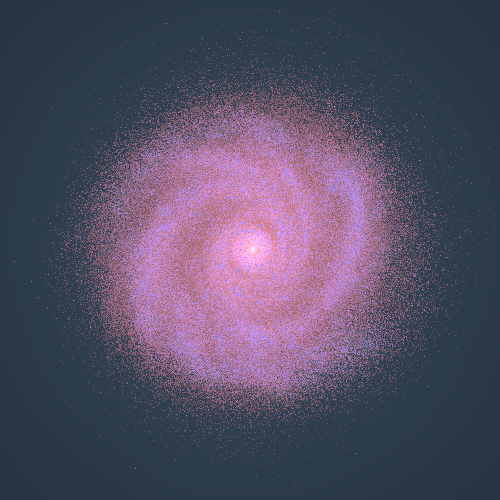 Face on view of a spiral galaxy similar to the Milky Way.
This simulation took 100,000 CPU hours on the TACC Lonestar cluster to complete.
Face on view of a spiral galaxy similar to the Milky Way.
This simulation took 100,000 CPU hours on the TACC Lonestar cluster to complete.
 A very high-resolution simulation of the formation of a dark matter
halo in its cosmological context.
This simulation has a spatial resolution of a few hundred light years
and
the mass resolution of a few thousand of solar masses (the size of a
small
star cluster). It took 100,000 CPU hours on the ARSC Power4 to complete and will allow us
to measure the density profile of a galaxy sized dark matter halo with
unprecedented detail down to its very center.
A very high-resolution simulation of the formation of a dark matter
halo in its cosmological context.
This simulation has a spatial resolution of a few hundred light years
and
the mass resolution of a few thousand of solar masses (the size of a
small
star cluster). It took 100,000 CPU hours on the ARSC Power4 to complete and will allow us
to measure the density profile of a galaxy sized dark matter halo with
unprecedented detail down to its very center.
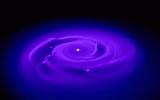 A simulation of a protoplanetary disk shows gas giant planets forming in
hundreds of years. The color coding is by density and shows about half a dozen
planets formed between 8 and 20 AU from a solar-type star. Also see a face on view. The simulation was
run on PSC Compaq Alphaserver Cluster.
See the
article in Science.
A simulation of a protoplanetary disk shows gas giant planets forming in
hundreds of years. The color coding is by density and shows about half a dozen
planets formed between 8 and 20 AU from a solar-type star. Also see a face on view. The simulation was
run on PSC Compaq Alphaserver Cluster.
See the
article in Science.
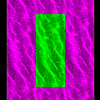 Saturn's rings are being simulated as self-gravitating, colliding
chunks of ice. 200,000 particles are put down in a small patch and
evolved under their own gravity and the shearing tide of Saturn. In
green is the original patch, while replicas are shown in magenta.
Spiral structure forms on a length scale of about 50 meters. It is
hoped that the Cassini mission to Saturn will have enough resolution
to detect these features. This simulation was performed on the
ARSC Cray T3E.
Saturn's rings are being simulated as self-gravitating, colliding
chunks of ice. 200,000 particles are put down in a small patch and
evolved under their own gravity and the shearing tide of Saturn. In
green is the original patch, while replicas are shown in magenta.
Spiral structure forms on a length scale of about 50 meters. It is
hoped that the Cassini mission to Saturn will have enough resolution
to detect these features. This simulation was performed on the
ARSC Cray T3E.
 The Sloan Volume, a 100 Mpc slice of a 1,000 Mpc volume at a
redshift of 0 and bias of 1 using CDM initial conditions in a critical density
Universe. The color scale
represents a factor of 3000 in density. We also have a model with a
bias of 2.
These models were simulated with
47 million particles on the
Pittsburgh Supercomputer Center CRAY T3D. The dynamic range of this
simulation (at a redshift of 2) can best be seen in this
mosaic, where each
panel is a magnification by a factor of 2. For a better view of this
simulation, we have a
VRML and an
Inventor description
of a 80 Mpc subcube at a redshift of 0 and a bias of 1.4. The colors of
the particles represent a factor of 1 million in density.
The Sloan Volume, a 100 Mpc slice of a 1,000 Mpc volume at a
redshift of 0 and bias of 1 using CDM initial conditions in a critical density
Universe. The color scale
represents a factor of 3000 in density. We also have a model with a
bias of 2.
These models were simulated with
47 million particles on the
Pittsburgh Supercomputer Center CRAY T3D. The dynamic range of this
simulation (at a redshift of 2) can best be seen in this
mosaic, where each
panel is a magnification by a factor of 2. For a better view of this
simulation, we have a
VRML and an
Inventor description
of a 80 Mpc subcube at a redshift of 0 and a bias of 1.4. The colors of
the particles represent a factor of 1 million in density.
 We also have the the same volume at a redshift of 0.0 in a
low density Universe (Omega = 0.3 and bias of 1.0). A model with
Omega = 0.4 (bias 1.27) was also run.
Compare the structure seen in this
mosaic of magnified
views with that in the critical density simulation above.
These are also 47 million particle simulations run on the
Cornell Theory Center IBM SP-2.
We also have the the same volume at a redshift of 0.0 in a
low density Universe (Omega = 0.3 and bias of 1.0). A model with
Omega = 0.4 (bias 1.27) was also run.
Compare the structure seen in this
mosaic of magnified
views with that in the critical density simulation above.
These are also 47 million particle simulations run on the
Cornell Theory Center IBM SP-2.
 A coma size
cluster
was chosen from the above Omega = 1.0 simulation and resimulated in
high resolution, while keeping all the large scale power. This snap shot is
50Mpc across centered on the cluster. This simulation has only 700 thousand
particles, but its effective resolution is that of 3 billion particles.
A higher resolution
simulation resolves this cluster into a thousand subhalos.
A coma size
cluster
was chosen from the above Omega = 1.0 simulation and resimulated in
high resolution, while keeping all the large scale power. This snap shot is
50Mpc across centered on the cluster. This simulation has only 700 thousand
particles, but its effective resolution is that of 3 billion particles.
A higher resolution
simulation resolves this cluster into a thousand subhalos.
 This is a cluster of galaxies comparable to
Virgo at a redshift of 0.0.
The color scale represents 4 orders of
magnitude in density starting at the virial density.
The box extends to 4 megaparsecs in radius: twice the virial radius.
This simulation was run on the ARSC Cray T3D.
You may also
compare
the low resolution CRAY simulation
to the high resolution parallel simulation shown to
the same scale and at a redshift of 2. There is a VRML version of a moderate
resolution
simulation of this cluster. An even higher resolution version of this
cluster with 10 million particles has been run to a redshift of 4 on the
NCSA
Origin 2000.
This is a cluster of galaxies comparable to
Virgo at a redshift of 0.0.
The color scale represents 4 orders of
magnitude in density starting at the virial density.
The box extends to 4 megaparsecs in radius: twice the virial radius.
This simulation was run on the ARSC Cray T3D.
You may also
compare
the low resolution CRAY simulation
to the high resolution parallel simulation shown to
the same scale and at a redshift of 2. There is a VRML version of a moderate
resolution
simulation of this cluster. An even higher resolution version of this
cluster with 10 million particles has been run to a redshift of 4 on the
NCSA
Origin 2000.
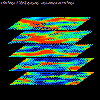 The results
of a 3 million particle CDM (Cold Dark Matter) simulation
is shown smoothed at 10 Mpc, with overdensities between -0.8 (blue)
and 1.4 (red). The
simulation produces much higher dynamic range in densities,
than can be seen at this smoothing scale. Take a look at the
MOVIE of the
structure formation in this simulation.
The results
of a 3 million particle CDM (Cold Dark Matter) simulation
is shown smoothed at 10 Mpc, with overdensities between -0.8 (blue)
and 1.4 (red). The
simulation produces much higher dynamic range in densities,
than can be seen at this smoothing scale. Take a look at the
MOVIE of the
structure formation in this simulation.
 Formation of a quasar host: the
result of a high resolution SPH simulation of a region that showed
early structure formation in our large cosmological simulation.
The
abstract
of the paper describing this simulation is available.
The full
paper is available in our
ftp-site,
in the file pub/hpcc/quaslett.ps.Z .
Formation of a quasar host: the
result of a high resolution SPH simulation of a region that showed
early structure formation in our large cosmological simulation.
The
abstract
of the paper describing this simulation is available.
The full
paper is available in our
ftp-site,
in the file pub/hpcc/quaslett.ps.Z .
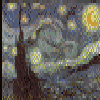 The Universe as seen by Vincent: perhaps the most famous
TIPSY image of the Universe. The Universe as seen by Vincent: perhaps the most famous
TIPSY image of the Universe.
Here are some links to images that are important to our project:
 COBE maps: initial conditions for simulations of large scale structure
are constrained by the power spectrum of fluctuations seen by COBE.
COBE maps: initial conditions for simulations of large scale structure
are constrained by the power spectrum of fluctuations seen by COBE.
| 



 N-Body Home
N-Body Home About Us
About Us Search
Search Contact Info
Contact Info